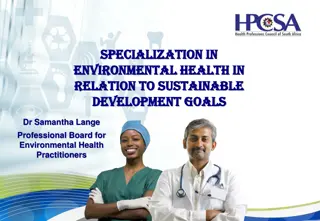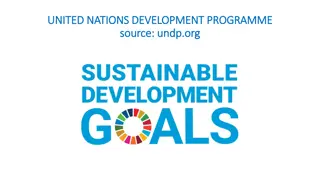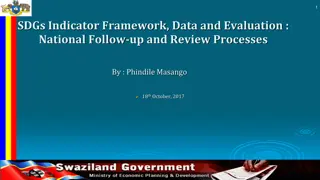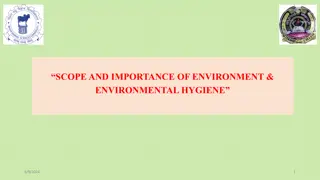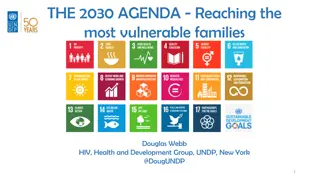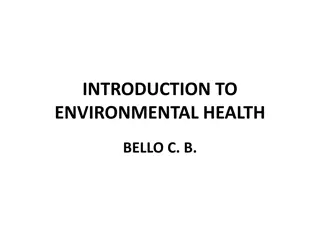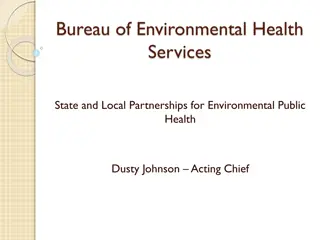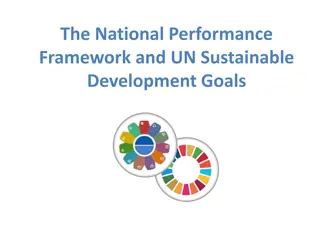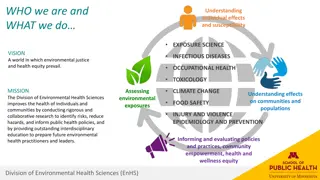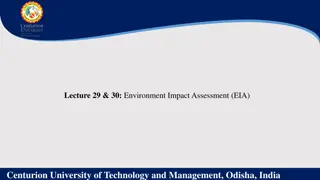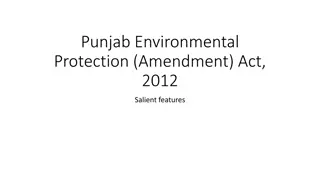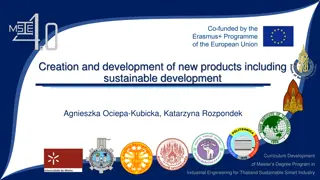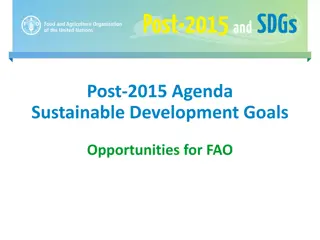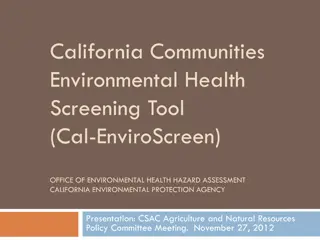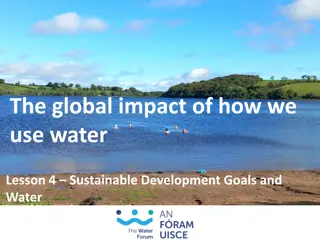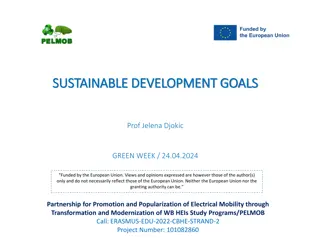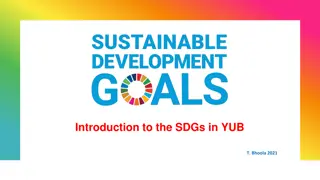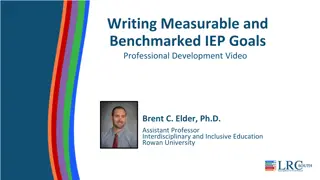Environmental Health and Sustainable Development Goals - NDoH Presentation
On World Environmental Health Day 2022, Mr. DN Nkuna from NDoH presented on the strategic alignment of environmental health to SDGs. The purpose was to share departmental activities progressing towards SDGs, highlighting environmental health's role in achieving them. Background information emphasized the importance of SDGs in global development, stressing the need for national frameworks and data collection to monitor progress. The presentation outlined the cluster's goal of improving environmental health services across all districts and municipalities, aligning with NDP and SDGs.
Download Presentation

Please find below an Image/Link to download the presentation.
The content on the website is provided AS IS for your information and personal use only. It may not be sold, licensed, or shared on other websites without obtaining consent from the author. Download presentation by click this link. If you encounter any issues during the download, it is possible that the publisher has removed the file from their server.
E N D
Presentation Transcript
WORLD ENVIRONMENTAL HEALTH DAY 2022 Environmental Health and Implementation of Sustainable Development Goals (SDGs) NDoH Mr DN Nkuna 26 September 2022 1
Presentation Outline Purpose Background Strategic Alignment to SDGs Contribution of Environmental Health to the SDGs Way Forward for environmental health to the achievement of the SDGs
Purpose To share the departmental activities aimed at achieving alignment to the SDGs. To provide progress made towards the achievement of the SDGs To highlight strides made by environmental health at all levels towards the achievement of the SDGs
Background On 1 January 2016, the 17 Sustainable Development Goals (SDGs) of the 2030 Agenda for Sustainable Development adopted by world leaders in September 2015 at an historic UN Summit officially came into force. Over the next fifteen years, with these new Goals that universally apply to all, countries will mobilize efforts to end all forms of poverty, fight inequalities and tackle climate change, while ensuring that no one is left behind. Hence the logo at the bottom of all government presentation slides to remind Managers about the commitment. The SDGs, also known as Global Goals, build on the success of the Millennium Development Goals (MDGs) and aim to go further to end all forms of poverty. The new Goals are unique in that they call for action by all countries, poor, rich and middle-income to promote prosperity while protecting the planet. They recognize that ending poverty must go hand-in-hand with strategies that build economic growth and addresses a range of social needs including education, health, social protection, and job opportunities, while tackling climate change and environmental protection.
Background While the SDGs are not legally binding, governments are expected to take ownership and establish national frameworks for the achievement of the 17 Goals. Countries have the primary responsibility for follow-up and review of the progress made in implementing the Goals, which will require quality, accessible and timely data collection. Regional follow-up and review will be based on national-level analyses and contribute to follow-up and review at the global level. https://www.un.org/sustainabledevelopment/development-agenda-retired/ Every department in the Country including the department of health is participating in the analysis on the progress implementation of the SDGs. The analysis has been taking place since 2017 as the baseline. The department has committed to the achievement of the goals and targets set in the SDGs. The Theme for 2022 states that: Strengthening Environmental Health Systems for the implementation of the Sustainable Development Goals.
Background The cluster Environmental Health and port Health Services has set a strategic goal of Improving environmental health services in all 52 districts and metropolitan municipalities in the country. The above-mentioned objective aligns to the NDP and SDGs as it will be outlined below. NDoH can only achieve to contribute to the SDGs if all stakeholders contributing to the performance of environmental health services align their activities to the national plan. The cluster is aware that the department only reports on SDG3 currently.
Strategic Alignment to SDGs Sustainable Development Goals Adopted 2015 National Development Plan 2030 Adopted in 2012 District Health Offices Strategic Plan District Health Plan National Department of Health Annual Performance Plan Operational Plan Integrated Development Plan Municipalities: DMs and Metros Provincial Health Plan Service Delivery Implementation Plan Provincial Departments of Health Annual Performance Plan Strategic and other documents should reflect contribution of EHP s to the SDG s Operational Plan
Contribution of Environmental Health to the SDGs Environmental Health contribution to the SDGs is reliant on availability of strong environmental health systems. The International Federation of Environmental Health (IFEH) in their website stated that Environmental Health plays a pivotal role in the implementation of the Sustainable Development Goals (SDGs) and with a well institutionalized Environmental Health Systems the targets set will be easily achieved. 8
Contribution of Environmental Health to the SDGs In order for EH to contribute towards the achievement of SDG goals by the department and ultimately the country, a framework for strengthening environmental health systems must be in place. In prioritising this, the department has developed strategic documents and prioritised strategic activities that seek to strengthen the provision of environmental health services. National Environmental Health Policy Environmental Health Strategic plan National Norms and Standards Monitoring implementation of Norms and Standards Monitor implementation of IHR, 2005 core capacities Heat and health Plan Action Guidelines Domestic Indoor Air Quality guidelines South African National Lead Exposure Prevention Strategy Guidelines for Investigation & Environmental Control of Human Chemical Exposure & Poisoning Cases Port Health Resource Improvement Plan
Contribution of Environmental Health to the SDGs SDG SDG 2. End hunger, achieve food security and improved nutrition and promote sustainable agriculture Target By 2030, end all forms of malnutrition, including achieving, by 2025, the internationally agreed targets on stunting and wasting in children under 5 years of age, Contribution by EH EH ensures that food safety is observed to achieve food security through certification, inspection, awareness and investigation by municipalities and Port Health
Contribution of Environmental Health to the SDGs SDG Target Contribution by EH SDG 3. Ensure healthy lives and promote well- being for all at all ages end preventable deaths of new-borns and children under 5 years of age. end the epidemics of AIDS, tuberculosis, malaria and neglected tropical diseases and combat hepatitis, water-borne diseases and other communicable diseases. substantially reduce the number of deaths and illnesses from hazardous chemicals and air, water and soil pollution and contamination Implementation of surveillance measures for prevention, early detection and response to communicable diseases. Assessment of core capacities to ensure compliance to IHR,2005. Monitoring of imported hazardous substances to ensure compliance with legislation.
Contribution of Environmental Health to the SDGs SDG Target Contribution by EH SDG 6. Ensure availability and sustainable management of water and sanitation for all By 2030, achieve universal and equitable access to safe and affordable drinking water for all. By 2030, achieve access to adequate and equitable sanitation and hygiene for all and end open defecation, paying special attention to the needs of women and girls and those in vulnerable situations . By 2030, improve water quality by reducing pollution, eliminating dumping and minimizing release of hazardous chemicals and materials, halving the proportion of untreated wastewater and substantially increasing recycling and safe reuse globally. Water quality monitoring to ensure safety of drinking water . Environmental role is that of compliance monitoring on issues of water quality. For protection of public health, we monitor that the water provided by Water Services Authorities and Providers is fit for human consumption. SDG 6.2 lifts hygiene as on integral part of sanitation provision. EH is directly responsible for hygiene behavior change promotion for the purpose of breaking the cycle of disease. In addition, through health surveillance of premises, the compliance monitoring role is activated.
Contribution of Environmental Health to the SDGs SDG SDG 8. Promote sustained, inclusive and sustainable economic growth, full and productive employment and decent work for all. Target Protect labour rights and promote safe and secure working environments for all workers, including migrant workers, in particular women migrants, and those in precarious employment. Contribution by EH EH provide inspection services and works in collaboration with labour inspectors to address occupational health issues.
Contribution of Environmental Health to the SDGs SDG Target Contribution by EH SDG 11. Make cities and human settlements inclusive, safe, resilient and sustainable. By 2030, ensure access for all to adequate, safe and affordable housing and basic services and upgrade slums. Through health surveillance of premises. The health sector as a whole is a potential contributor to negative environmental impacts. The management of environmental related aspects of provision of heath care services in health facilities is a critical role that EH plays.
Contribution of Environmental Health to the SDGs SDG Target Contribution by EH SDG 11. Make cities and human settlements inclusive, safe, resilient and sustainable. By 2030, reduce the adverse per capita environmental impact of cities, including by paying special attention to air quality and municipal and other waste management. EH plays an important role in air quality management. EH working together with other stakeholders have been monitoring outdoor air and in other areas even indoor air. EH is part of stakeholders that sit in all Air Quality Priority Areas meetings. The department has a Domestic Indoor Air Quality guidelines which seeks to guide EHP s on monitoring indoor air within households. Education and awareness has been playing a critical role in prevention and managing exposures and illnesses associated with such.
Contribution of Environmental Health to the SDGs SDG SDG 12. Ensure sustainable consumption and production patterns Target By 2030, achieve the environmentally sound management of chemicals and all wastes throughout their life cycle, in accordance with agreed international frameworks, and significantly reduce their release to air, water and soil in order to minimize their adverse impacts on human health and the environment . Contribution by EH Inspection of imported hazardous substances at points of entry to ensure safety for human health. EH plays an important role in pollution prevention through inspection, awareness campaigns and investigation of pollution activities. A draft regulation to strengthen enforcement has been developed and pending promulgation
Contribution of Environmental Health to the SDGs SDG SDG 12. Ensure sustainable consumption and production patterns Target By 2030, achieve the environmentally sound management of chemicals and all wastes throughout their life cycle, in accordance with agreed international frameworks, and significantly reduce their release to air, water and soil in order to minimize their adverse impacts on human health and the environment . Contribution by EH A draft regulation on Lead in Paint or coating materials to strengthen enforcement has been developed and pending promulgation. Draft Notices on Groups I & II hazardous substances have been developed & pending promulgation which is aligned to the Globally Harmonized System for Classification & Labelling of Chemicals.
Contribution of Environmental Health to the SDGs SDG Target Contribution by EH SDG 13. Take urgent action to combat climate change and its impacts. Strengthen resilience and adaptive capacity to climate-related hazards and natural disasters in all countries. EH to incorporate climate change mitigation and adaptive measures as part of the functions they render. This include being part of the Outbreak Response Teams, Integrated Surveillance Disease Response (ISDR) and Joint Operations Committees (JOC) across all spheres of government. Stakeholders including EH are being capacitated on the Heat and Health Action guideline developed. The department working with DFFE, is developing a climate change and health adaptation strategy. Continuous education of communities including other stakeholders on climate change impacts is key for preserving the environment for the future generation.
Recommendations Environmental Health Services is rendered at District, Metropolitan Municipalities, Points of Entry, Provinces, Private Sector, SANDF, Correctional Services, District Health Hospital and Other Government Departments, therefore: NDoH to ensure that EHS forms part of the M&E reporting every second year. Documentation and alignment of all plans to the SDGs is strengthened. All stakeholders should participate in the regular reporting to ensure that wholistic coverage is achieved.
Managers who contributed to the Presentation B Nemukula Managers Managers B Makhafola APR Cele MAM Ramathuba; A Hargreaves; O Jacobs and F Bongweni P Masilela B Nemukula R Loykisoonlal B Makhafola Z Mntambo M Mainganye DN Nkuna M Maringa and P Mahalefa P Masilela A Menyatso M Mainganye S Mdlalose R Loykisoonlal F Makobe



